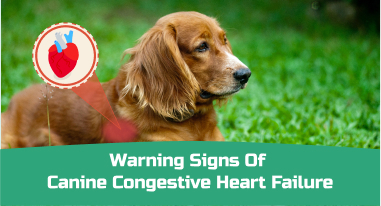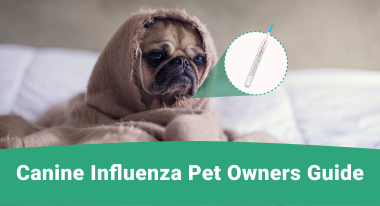Table of Contents
Visual impairments in your pet bring a drastic change in its life. As a pet parent, it is heart-wrenching to know that your best companion is losing vision. Your extra care and compassion towards the dog can help your pet sailing through the difficult phase of its life. Your pet’s vision impairment also affects you as a pet owner, but you can help your pet utilize its other senses to get a drift with the new life changes and make your furry friend live as happy as possible.
This article takes you through the symptoms that help you assess that your dog may be suffering from vision loss and a detailed outline of care you should provide to help your dog with visual impairment. Read the article to get additional information on the importance of consulting a vet and blind dog training tips to help your canine companion deal with the sudden life changes brought by visual impairment.
What Are The Dog Blindness Symptoms?
You may notice some physical irregularities and behavioral changes among your dogs, indicating losing sight. We have enlisted some of the significant signs:
Signs your dog is losing its vision
Physical Irregularities You May Notice
- Swelling or redness around the eyes
- Visible spots in the eyes
- Dogs get noticeable eye pain
- They get startled easily
- Your dog’s eyes look cloudy
- You can notice abnormalities in the dilation of your dog’s pupils.
Behavioral Changes Among Dogs Losing Their Vision
- You can notice anxiety among dogs when approached,
- You can see them bumping into furniture, walls, obstacles, etc.
- Dogs may not make proper eye contact,
- Your dogs may lose interest in things they were excited about earlier,
- Your dogs tend to avoid stairs and furniture.
How do Vets Help Your Visually Impaired Dog?
If you find any signs indicating that your dog is losing its vision, please take your dog to a vet near you. Your general vet may refer you to a veterinary ophthalmologist (eye specialist for pets), or you can find one using GreatVet – the most trustworthy online vet discovery platform.
Vet ophthalmologists examine your dog’s condition and conduct some tests to determine the severity of vision loss. These tests will help rule out possibilities of underlying conditions like diabetes or Cushion’s Disease.
During the physical examination, vets test your dog’s pupil reaction time, reflexes, body temperature, weight, respiration, heart rate, pulse oximetry, and blood pressure.
Vets may also conduct tests, like blood glucose, urine analysis, comprehensive metabolic panel, count of red blood vessels, serum analysis, ocular ultrasound, and more.
The vets determine if your dog has gone completely blind or it is suffering from Sudden Onset Blinding Disease. According to the Science Daily, Iowa State University Veterinary Researchers are on their way to finding a cure for previously incurable sudden blindness among dogs. This can be a ray of hope for pet parents and their dogs suffering from visual impairment.
Vet ophthalmologists decide on a line of treatment based on the test results and educate you on caring for a visually impaired dog. Most dogs suspected of going blind lead a happy life if their parents adapt the vet’s directives to provide a suitable environment and utmost care.
How to Care for a Visually Impaired Dog
Many dogs may feel left apart as they face vision loss. However, you can help your dog lead a happy and comfortable life like other animals, following some tips provided by the experts.
Tips for Living with Blind Dogs
Caring for a blind pet may seem challenging to many dog owners. However, you can help your dogs adjust to the situation through a consistent routine. Let your dog cope with some new additions to its practice and train it to carry out its daily activities effortlessly.
How to Approach and Greet a Visually Impaired Dog?
The effective way is to approach slowly, talking to the dog all the time. Ensure you keep an arm’s distance from the dog. You won’t confuse the dog if you follow these techniques. Crouch down, form a fist with your palm and keep it at the nose level. Let the dog create a feeling of familiarity. Let the dog sniff your hand and come closer to you.
Talk to Your Dog Frequently
Keep interacting with your dog frequently by using a pampering tone. Your attention and affection give confidence.
Making Your Home ‘Dog proof.’
Making your home suitable for the pet is crucial to help it lead a comfortable life ahead. Focus on creating a safe zone for your dog. Work out a proper floor plan with bare floors free from obstacles and potential hazards.
Location Cues
Creating location cues will help the dog navigate through your house freely. Avoid sharp objects on the floor or along some feet of height for safety. Sharp edges on knives, furniture, and other things may cause injuries.
Keep your dog’s essentials, like food and water bowls, in the same spot – so that your dog can reach them following the same route. Take preventive measures to protect your dog from other pets.
Use baby gates to mark locations. Another simple technique is to place rugs and carpet runners through its path to reach its bedding or food. Area rugs with different textures serve as the guidelines for your dog’s indoor walks. It will never feel lost when it smells and finds almost everything in the same place.
How to Walk a Blind Dog?
Regular walks must be a part of your b dogs’ routine. Take the dog on a leash and guide it through your voice commands, like ‘Careful!’ if it is about to hit an obstacle. Start with indoor walks through various rooms, and then gradually take your visually impaired dogs outdoors for regular walks.
Tools for Blind Dogs
Here are some objects you can use to help your dogs lead an everyday life.
Food and Water Bowls
Keep food and water bowl in the same place.
Dog treat
Continue providing delicious and nutritious dog treats for positive reinforcement.
Dog Toys
Ensure your dog’s favorite toy is a noise-making toy. It makes noise and helps your visually impaired dog determine the toy’s location during playtime. A squeaky toy with some noticeable spots and curves on it helps dogs to identify it.
Dog’s Collar
A collar with an inbuilt speaker can help you pass voice commands to your dog suffering from vision loss.
Baby Gates
Use baby gates to denote the territory of your visually impaired dogs.
Essential oil
Aromatic essential oil helps your dog smell and recognize an object quickly.
How to Train a Blind Dog?
Most dogs learn through visual signals and hand signals during training. However, as your dog might have lost its sight, you need to adopt new commands as your verbal cues and some new smells to train your dog.
To build confidence among your dogs, walk with them through your entire house. Let it gain familiarity with furniture placement and use textured mats to guide your dogs through various parts of your home.
A few tips to help a blind dog adjust and be safe
- Create a ‘scent map’ for your dog.
- Use ‘luring’ or ‘capture’ methods with training treats to teach fundamental movements like sitting and lying down.
- Use consistent and straightforward verbal cues.
- Prefer unique sounds like your whistles in different tones instead of words or hand signals.
The following infographic summarizes the caring tips for blind dogs. The crisp explanation and graphical representation will help you understand and remember these care tips for a long time. Take a glance at the infographic and implement these tips to help your visually impaired dogs:

To Summarize
The article and the following infographic cover caring tips to help your dogs lead a comfortable life. We hope that dogs’ various aspects of blindness will help you provide better care for your furry pals with visual impairment.
Use GreatVet to find the best-rated vets in your area and schedule an appointment for your pets.
Disclaimer: The content on the site is for educational purposes only, and it does not provide medical advice. The shared information must not be treated as a substitute for or alternative for medical practitioner advice, diagnosis, or treatment. Regarding any concerns about your pet’s health, seeking veterinary guidance is of utmost necessity. Each pet has specific health, fitness & nutrition needs. Do not disregard, avoid or delay pet health-related advice from veterinarians based on reading the information provided on this site.


